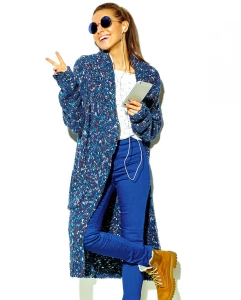From Factories to Digital Stores: The First Steps Toward Automation
The digital transformation in fashion began inside factories, where computer-aided design (CAD) systems were adopted in the stages of pattern preparation and cutting layout. The process later expanded to include automated systems in production and distribution. Over time, it became natural for stores to move into the digital space, with ready-to-wear clothing displayed on online platforms that analyze consumer shopping behavior.
The Impact of Digital Transformation on Supply Chains and Fabric Manufacturing
The adoption of technology directly affected production speed and accuracy. Tools powered by artificial intelligence emerged to track shipments and manage inventory in real time. In the fabric industry, technical research led to the development of new, more flexible and sustainable materials, such as recycled or biodegradable textiles. This marked an important step toward a more eco-conscious fashion future.
How Has Artificial Intelligence Changed Clothing Design and Presentation?
Smart Fashion Design Through Algorithms and Machine Learning
Today, several fashion brands use algorithms that analyze images and data from various social media platforms to identify new patterns and trends. These algorithms are used to generate designs that match the preferences of target audiences more accurately than ever before, accelerating the pace of innovation in global fashion.
Using Predictive Technologies to Analyze Fashion Trends
Artificial intelligence has made it possible to track fashion trends proactively. Instead of relying entirely on seasonal runway shows, companies now predict upcoming styles based on image analysis, search behavior, and product interaction data. This allows many designers to stay at the forefront of the industry.
Personalized Shopping Experiences Through AI Tools
Shopping experiences have evolved from random selection to personalized journeys that begin the moment a visitor enters a website. User preferences are analyzed to offer accurate recommendations tailored to individual styles and needs. This level of personalization increases purchase rates and makes customers feel like the service is uniquely tailored to them.
Has This Shift Affected Consumer Taste?
The Evolution of Consumer Preferences in the Age of Big Data
With continuous exposure to digital fashion content, consumer preferences have changed significantly. Purchasing decisions are no longer based only on appearance or price but are now influenced by the overall user experience, the practicality of clothing in everyday life, and brand values such as sustainability or innovation.
The Role of Artificial Intelligence in Offering Smart Shopping Suggestions
Thanks to AI technologies, it is now possible to provide highly accurate shopping suggestions based on browsing history, past purchases, and even the weather in a user’s location. These features have helped strengthen the relationship between brands and consumers and have improved the quality of the shopping experience overall.
 How Has Modern Jeans Design Changed Through Artificial Intelligence?
How Has Modern Jeans Design Changed Through Artificial Intelligence?
From Classic Cuts to Interactive Designs
Jeans have evolved significantly in recent years. Cuts are no longer limited to classic styles; they have become more diverse and interactive, driven by data analysis on usage and comfort. New cuts are designed to adapt to movement and provide greater comfort throughout the day. Mamily Jeans is one of the leading platforms keeping up with these developments, offering modern jeans collections that match the needs of contemporary fashion in terms of cut and fabric.
Jeans and the Future: Innovative Materials and Smart Tailoring Technologies
The development of jeans now relies on technical components such as laser-treated fabrics or textiles blended with plant-based fibers. Today, digital tailoring systems are used based on precise measurements collected electronically, helping to reduce waste and improve fit. By browsing the Mamily Jeans website, it’s easy to see how the brand merges modern taste with smart technologies to offer jeans that meet daily life needs and the expectations of Fashion 2025.
Toward a More Conscious and Advanced Fashion Industry
Artificial intelligence is no longer just a complementary tool in fashion—it has become a fundamental part of every stage, from clothing design to fabric manufacturing to shaping consumer preferences. While aesthetics remain important, precision, sustainability, and technology now play a central role in defining the future of Fashion 2025 and beyond.



